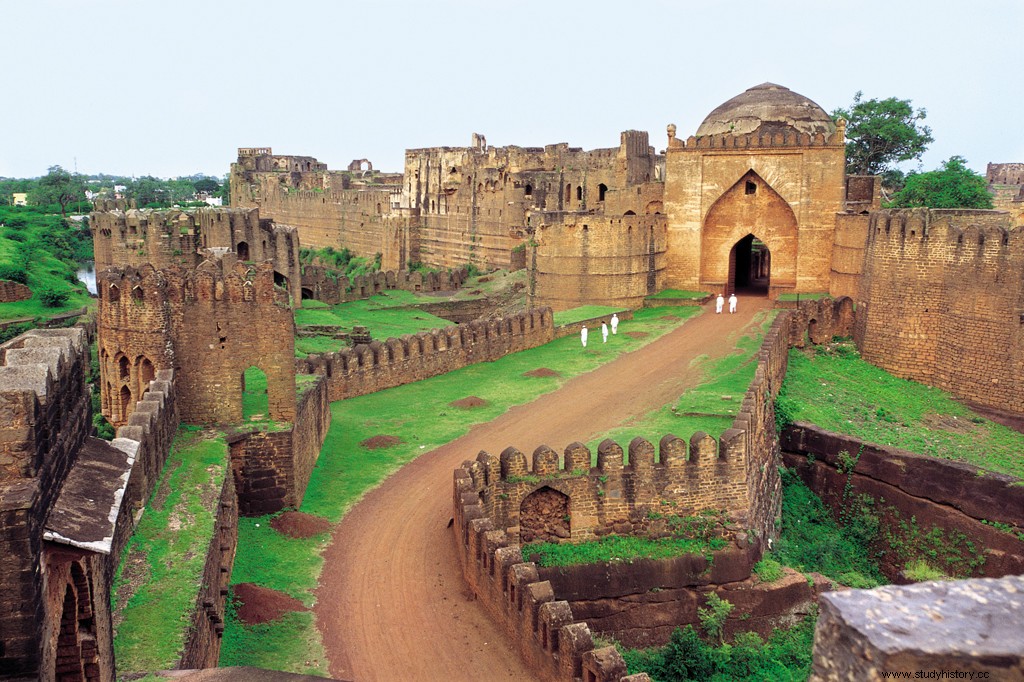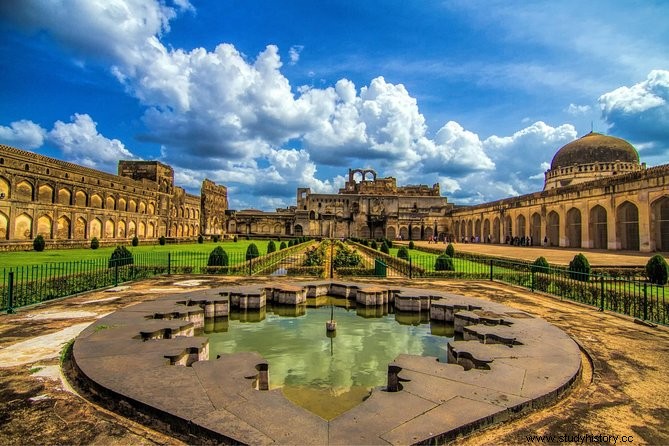Prataparudra (1289–1323 AD) who was known as Rudradeva-II was the last king of the Kakatiya dynasty. His capital was Warangal. Possibly the descendants of the Kakatiya dynasty are known today as the Reddy caste. He was the grandson of Queen Rudramadevi of Kakatiya dynasty who is counted among the great rulers of Kakatiya dynasty. Many films have also been made in South India in the name of Maharani Rudramadevi. Harihara and Bukka, who founded the Vijayanagara Empire in the south, were the treasurers of the Kakatiya kingdom during these times. Pralay Nayak, the ancestor of the Nayak caste of Andhra-Telangana, was their general and other military officers.
It was during this time that Shaitan Ulugh Khan (future Muhammad bin Tughlaq) attacked Warangal, the capital of the Kakatiyas. But Prataparudra's army ran and killed the invading Ulugh Khan's army. They looted their military camp and drove them to Kotagiri. Ulugh Khan fled to Devagiri with his army.
Muslim historian Ziauddin Barani writes, “There were many Hindu soldiers in the Mati fort and Pashan fort of Warangal. There were intense clashes every day. Heavy fire rained from the fort and many people were killed on both sides. Ulugh Khan (Muhammad bin Tughlaq) had made a firm intention to demolish the fort and take Rai captive. In this way the desperate Hindus surrounded by all around were running the talk of compromise. By then it had been a month and there was no news of the Sultan from Delhi….Ulugh Khan and his courtiers estimated that some posts on the route had been destroyed….Panic and apprehension spread among the soldiers…everyone took their own Measured the way… Shayar Ubaid and Shekhzad-i-Dimakshi went to Malik Tamar, Malik Tigin, Malik Malla Afghan and Malik Kafur (another) and told (to them) that Ulugh Khan looked at them with envy and suspicion… People made a plan to run away…. Panic spread in the army… The surrounded people attacked and looted the goods. Ulugh Khan with his men retreated to Devagiri.”
Muslim historian Isami has also described something similar. Historian Purushottam Nagesh concludes from this description of Oak Barani that, “Rai Prataparudra Deva (or Laddar Deva) of Warangal defeated the Muslim army of Ghiyasuddin very badly. He closed the way for the people to escape. Correspondence and supply routes closed. He made the situation of the Muslim army so thin that there was a sharp difference of opinion among them. Hindu loot of enemies and Hindu goods were once again returned to the Hindus. Muslim invaders were driven away to Devagiri."
The attack was so back-breaking and brutal that “the soldiers were battered, they fled wherever they got the chance…. The fleeing elites also found their way, their soldiers and slaves were destroyed, their horses and weapons fell into the hands of the Hindus. Malik Tamar (accidentally) with some of his riders entered the Hindu territory and ended up there. The Hindus also killed Malik Tamar and sent his skin to Ulugh Khan to Devgiri (as Ulugh Khan had done to Harpal Dev, the ruler of Devagiri). (Those people) sent many people like Malik Mall Afghan, Shayar Ubaid etc. to Devgiri, as described by historian Ziauddin Barani. (Iliad and Dawson, pages 231-233)
When news of the Muslim crisis and defeat at the hands of the brave Hindus of Telangana reached Ghiyasuddin, he "imprisoned the wives and sons of the rebels." Barani further wrote that “The Sultan called a common court in the field of Siri (Shri). There, the poets Ubaid and Malik Kafur were crucified alive along with other prisoners. He gave such harsh punishments to those people that the spectators used to tremble and tremble with fear for a long time. The whole city was shaken by the horrific vengeance of the Sultan (same page 233).
Satan Ulugh Khan's attack again
Prataparudra felt that he had achieved the final success, the Muslim army of the Delhi Sultanate would not attack his kingdom again and he became restless after disbanding the soldiers. And this proved to be his biggest mistake.
Like other North Indians, Prataparudra also made a mistake in understanding Muslims. He had not learned from the misfortune of North-West and North India. They were also unaware that the Muslim emperor and army used to kill infidels (non-Muslims), destroy their temples and idols and plunder their women. Just as we Hindus are taught since childhood that good deeds, charity, charity, charity, human service lead to heaven, similarly Muslims are taught to kill infidels, destroy their temples and idols, rape their women. Karna and Dar ul Harb i.e. making non-Muslim country an Islamic nation is the best way to achieve Paradise and 72 Hurs. Therefore they will not stop attacking the infidels wherever they get a chance.
Soaring with the pain of defeat, the Sultan sent "a mighty corps" to Ulugh Khan at Devagiri and ordered to attack Warangal once again. Only four months later “accordingly he entered the Tailang region and captured the Bidar (Bidar) fort and imprisoned its chief (same page 233).
The Muslims caused a lot of sabotage in the Bidar fort. The desolate and deserted ruins of Bidar still strike the hearts of the onlookers. The cunning leftist historians attribute the construction of Bidar fort to the Muslims, while Barani clearly admits that the Bidar fort was a Hindu built fort which was destroyed and corrupted by the Muslims and then later manipulated and freed from infidel signs. The tax was made for Islamic invaders to live in, as they had been doing from Arabia to the Middle East and North India until now.

Astu, Purushottam Nagesh Oak writes, “The Islamic epidemic moved towards Warangal by destroying and corrupting the flourishing Hindu city of Bidar. A few months ago, those people had run away after getting beaten up from here and taking their lives in despair. This time he kept the converted Hindus as scapegoats. Ulugh Khan attacked Warangal with an ambush. Unaware of the truth, the army of Warangal was defeated." And then with the force of terror and torture, the Muslims took control of it. Pratap Rudra was imprisoned along with his family and sent to Delhi and the same destruction Leela of murder, rape, temple-demolition and forced conversion started in Warangal.

Barani writes, “Laddara Deva (Prataparudra Dev) with all his nobles, officials, women, children, chariots of elephants and horses came under his authority. The information of victory was sent to Delhi. Warangal was renamed as Sultanpur and all the prisoners were sent to Delhi Ghiyasuddin Tughlaq.
According to various historians and records, King Prataparudra committed suicide on his way out of grief and guilt and thus the Kakatiya dynasty came to an end in South India forever. His kingdom was merged with the Delhi Sultanate. Ulugh Khan stayed there for a few days after renaming Warangal as Sultanpur. In 1324 AD he was called to Delhi. He went to Delhi, handing over the rule of Warangal to the newly converted Muslim Malik Maqbool, who was earlier a Kakatiya general. His Hindu name was Nagaya Gana Vibhudu.
Fearless rebellion of the heroes of Warangal
Even in these circumstances, the people of Andhra-Telangana did not give up. He started opposing the invading Muslims from his own level. One of them was Musunuri Kapaya Nayak, who organized the rebels and opposed the invading Muslims with full force. He was the nephew of Munusuri Pralay Nayak.
Munusuri Kapaya Nayak organized a huge Hindu army. There were 75 heroes in his army. There was rebellion in many states during the time of Shaitan Ulugh Khan, who had now become the Sultan of Delhi by the name of Muhammad bin Tughlaq after killing his father Ghiyasuddin Tughlaq. Taking advantage of that situation, Pralay Nayak raised the flag of rebellion in modern Andhra Pradesh and Munusuri Kapaya Nayak in Telangana state.
Pralay Nayak liberated the coastal Andhra Pradesh from the Muslims in 1328. In 1329, he, along with the Chalukya prince Somadeva, made Kurnul (Kondanavolu) his center and started attacking the invading Muslims in Belur and Rayalaseema region. After a fierce battle they again took back Anegondi, Mudgal, Musalimadugu, Satani Kot, Etagiri, Kunti and Sara Durg. Veer Ballal attacked Kampili. Malik Mohammad, the governor of Kampilya, now had to fight on two fronts simultaneously. On one side the army of Veer Ballal would attack and on the other side the army of Prince Somdev. Ultimately Somdev was able to defeat Malik Muhammad and took him captive along with his 6000 soldiers.
Liberation of Andhra-Telangana from Muslim invaders
By 1333 AD, the situation of Muslims in Andhra had deteriorated to a great extent. They started running towards Warangal where Malik Maqbool was the governor. In 1334-35, Muhammad Tughlaq went from Delhi to crush these rebels, but at that time cholera spread in Andhra and his army started dying due to cholera. Mohammad bin Tughlaq himself also started having diarrhea. Fearing to die of cholera epidemic, he fled back to Delhi after being wealthy.
By 1336, the way for the liberation of Warangal was also cleared as Kapaya Nayaka's forces had lashed out at the Muslim invaders in Telangana like Bunder and slowly began to take over those areas.
According to Farishta, Munusuri Kapaya Nayak appealed to King Birballal III of the Hoysalas in modern Karnataka at the same time for help, and after certain conditions, he agreed to help. Then the Nayak brothers and Veer Ballal together killed the Muslims in 1336. Imad-ul-Mulk, the governor of Warangal, fled to Daulatabad. The converted Muslim Malik Maqbool fled to Delhi in fear. (Ferishta, Tarikh-i-farishti)
Historian Purushottam Nagesh Oak writes, "The blood-soaked hands of the Sultan were not even dry yet that the news of the Sixth Rebellion also arrived. The brave Hindus of Warangal had caught the foreign Muslim wolves. Kanya (Kapaya) Nayak, a brave Hindu patriot, decided to make the Muslim Bagheres taste the Hindu sword. Sultan's Muslim henchman Malik Kabul was so frightened that he ran straight to Delhi without looking back. Andhra became completely free from Muslim plunder. Hope the memory of this great Hindu patriot of Warangal will still be fresh in the hearts of the residents there.”
The Nayak brothers restored the ancient glory and Vedic education and culture. He also restored the temples which had been destroyed and corrupted by the Muslims. Kapya Nayak then assisted and supported other Hindu rebels as well against the Muslim invaders. Around the same time, Harihara and Bukka also liberated Telangana from the Muslims and established the world famous Vijayanagara Empire.
